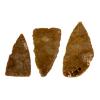
Q: What is the Lost World of Old Europe?
A: In 4500 BC, before the invention of the wheel or writing, before the first cities were built in Mesopotamia and Egypt, Old Europe was among the most sophisticated and technologically advanced places in the world. The term “Old Europe” refers to a cycle of cultures that thrived in Europe principally in the fifth and first half of the fourth millennia BC, then suffered what seems to have been a sudden collapse.
Q: Where in Europe did these cultures exist?
A: Old Europe refers to the cultures of southeastern Europe, centered in today’s Bulgaria and Romania, and also in parts of Moldova and Ukraine.

Q: What are some of the most noteworthy aspects of the pieces in the exhibition?
A: The pottery and figurines were decorated with striking designs. Female “goddess” figurines, found in almost every settlement, have triggered intense debates about the ritual and political power of women.
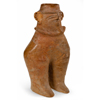
Q: Why is it called a “Lost” world?
A: Old Europe achieved a peak of creativity between 5000 and 3500 BC, but mysteriously collapsed. Later prehistoric European cultures developed in a different direction, with more widely dispersed populations, greater reliance on stockbreeding, and less investment in houses, pottery, and female symbols. Old Europe was utterly forgotten until it began to be rediscovered by archaeologists in the decades around World War I. In that sense it truly was “lost.”

Q: How advanced were the cultures of Old Europe?
A: At its peak, about 5000–3500 BC, Old Europe was developing many of the political, technological, and ideological signs of “civilization.” Some Old European villages grew to citylike sizes, larger than the earliest cities of Mesopotamia. Some Old European chiefs wore stunning costumes gleaming with gold, copper, and shell ornaments—displays of opulence that still surprise and puzzle archaeologists. Old European metalsmiths were, in their day, among the most advanced metal artisans in the world, and certainly the most active.
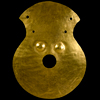
Q: What are the hallmarks of the cultures of Old Europe?
A: First, substantial, heavily built homes. Second, technically sophisticated pottery made of fine clays, often decorated with complex incised and painted designs. Third, figurines that portrayed females, frequently found in houses. And fourth, participation in a cycle of long-distance trade. Some of these traits—substantial houses often with room for visitors; dozens of different types of pottery (bowls, jugs, pots, pot stands, storage jars, and so on) made for elaborate service and display at social events; and figurines connected with domestic rituals—emphasized the importance of the home as a center of family, social, and ritual life.
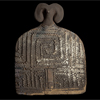
Q: Why are the female figurines such a special part of the exhibition?
A: One of the most famous aspects of Old Europe is the abundance of figurines, the majority of them females. The enigmatic female-centered cults of Old Europe have generated sharp disagreement among archaeologists, historians and feminists. The exhibition includes dozens of elaborately painted and decorated female figurines of many kinds and styles. The prevalence of female images among the anthropomorphic figurines of Old Europe have suggested to some that they mirrored a matrilineal and matrifocal Old European social structure, in which women were the dominant figures in social and political life.
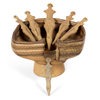
Q: What led to the sudden collapse of old Europe?
A: About 4300–4100 BC, more than six hundred settlements were burned and abandoned. People scattered and became much more mobile, depending for their food on herds of sheep and cattle rather than fields of grain. Exactly what happened to Old Europe is the subject of a long and vigorous debate. One possibility is that Old Europe collapsed in a period of intensified raiding and warfare caused by the migration into the lower Danube valley of people who were mobile herders, possibly mounted on horseback, from the steppe grasslands of Ukraine. A migration from the steppes does seem to have happened about the same time as the collapse, but whether it caused the collapse is debated.
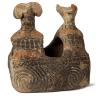
Q: Did Women Rule?
A: Female figurines predominate in Old European material culture. They can be found represented individually as well as in large groups, and in contexts identified as domestic, ritual, religious, and funerary. The proliferation of female imagery throughout the fifth and fourth millennia BC has prompted some scholars to interpret Old European culture as a peaceful world where female-centered goddess worship prevailed. Males, according to this theory, played a largely secondary role in society. Some scholars, however, consider this argument idealized—in fact many villages were fortified, weapons were buried with men, and adult males had the richest graves in cemeteries.

Q: What Was He Thinking?
A: One of the most famous figurines from Old Europe—“The Thinker”—represents a male seated on a low stool with his hands placed against his cheeks. The overall composition is frequently remarked upon for its affinities to modern art, and calls to mind the works of Picasso, Modigliani, and Brancusi. His unusual pose may have been meant to suggest a pensive state, but his precise thoughts, and even the meaning of his gesture, remain a matter of debate. It is important to note that the figurine’s final context was in a Hamangia grave, suggesting the possibility of a funerary significance. Is he lost in thought, or is he perhaps shown in mourning?
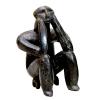
Q: Why Did They Burn Down Their Houses?
A: Archaeologists have long known that the houses in many Old European settlements were burned, but they attributed the frequent fires to warfare or natural accidents—the latter were probably a common occurrence in villages composed of thatched-roof homes. However, experimental fires set in modern replicas of Old European dwellings failed to produce the intense heat that is evident in the vitrified clay plaster of many archaeological houses. These modern experiments have convinced a number of scholars that certain Copper Age homes were filled with fuel and intentionally set ablaze. Fire is a purifying force, and was sacred in many ancient religions. In tell settlements, new houses were built on top of the leveled ruins of old burned houses, and it is possible that dwellings were destroyed by fire following the death of a revered elder or after a certain number of generations.

Q: Why Did They Vanish?
A: About 4300–4100 BC all of the known tell settlements in the lower Danube valley and eastern Bulgaria were burned and abandoned. Although Old European traditions survived and even thrived in the western and northern periphery of Old Europe, the tell settlements that had been occupied almost continuously for up to 2,000 years became silent mounds where sheep grazed. Marija Gimbutas of UCLA described the end of Old Europe as a war of the genders, in which patriarchal, horse-riding, Indo-European-speaking nomadic herders invaded from the arid steppes of southern Ukraine to destroy a peaceful world where females had been worshipped in Mother-Goddess cults. This idealized picture of Old Europe has not stood up to new archaeological evidence, but an alternate explanation is not yet widely accepted. It was probably a combination of declining agricultural yields, climate change, and conflict over resources, in addition to the arrival of immigrants from the steppes, that brought an end to Old Europe.
